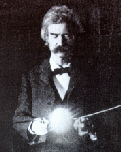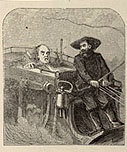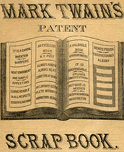



"I will write a book that will sell like fury," MT wrote Bliss in August 1870, "provided you put pictures enough in it." When published in February 1872, Roughing It contained 304 pictures. Less than three quarters of that total, however, were originally intended for MT's book, and when it wound up selling fewer copies than he'd expected, the illustrations were the first thing MT blamed. The pictures were drawn by perhaps as many as a dozen different artists. As Beverly David tells the story in Mark Twain and His Illustrators, Bliss initially hired Edward F. Mullen, whom MT had recommended in 1870 for his Burlesque Autobiography; Mullen's "E.F.M." is visible on about half a dozen illustrations. When illustrating began in the summer of 1871, anxieties about Mullen's reliability led Bliss back to True Williams, the principal illustrator for Innocents Abroad; the majority of signed illustrations in Roughing It have Williams' "TW" on them. MT's lateness in sending in manuscript and reports of Williams' drinking then prompted Bliss to commission additional pictures from Roswell Morse Shurtleff. You'll also see the name "Richardson" on several illustrations; he was an engraver -- the artist behind the pictures with his name of them was Henry Stephens. (Click on any of the images on this page to see the whole illustration.) |
 |
 |
 |
 |
Stephens's drawings, however, were originally drawn for an entirely different book: another of Bliss' publications called Beyond the Mississippi, by Albert Richardson (1869). Hoping to get MT's new book out before Christmas, 1871, Bliss resorted to one of the cost-saving measures that subscription publishers were notorious for: re-using old material as if it were new. It's impossible to be precise, but between 50 and 100 of the pictures in MT's book were originally drawn for other books. While some, like the first two below, fit MT's text fairly well, others, like the next two, may have confused contemporary readers. |
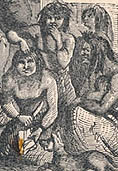 |
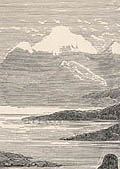 |
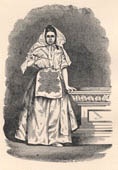 |
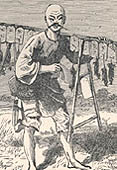 |
About the pictures drawn directly for Roughing It, it's not known what instructions Bliss gave the artists. Most of their illustrations do fall into several specific categories. These next four, for example, show how the book gave readers images of Western and Hawaiian landscapes -- in much the same way that Innocents Abroad contained serious representations of the cultural landmarks of the Old World. |
![Crossing the Platte [River]](riillC1.jpg) |
![The South Pass [through the Rockies]](riillC2.jpg) |
 |
![The Crater [of Kilauea Volcano]](riillC4.jpg) |
Many of the other drawings clearly try to capture something like "the spirit of the West" -- from the violence of the frontiersmen to the "tallness" of their tales to the risks they run from Indians to the joys of their outdoor lives. |
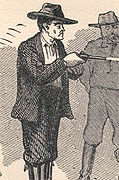 |
![[Bemus' Buffalo Hunt]](riillD2.jpg) |
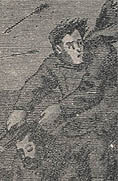 |
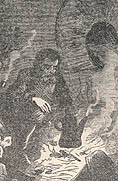 |
Also like Innocents Abroad, Roughing It contains a few depictions of real people, most of them famous, from the outlaw Slade to Horace Greeley. Somehow MT also got pictures of several of his friends to the illustrators. David identifies the "dissolute author" below, for example, as MT's fellow Virginia City reporter Dan De Quille. |
 |
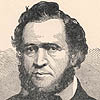 |
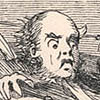 |
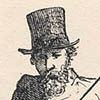 |
In his travels west MT encountered three racial groups that most of his eastern readers would have never met, and thus "knew" only through their representation in texts and images: "Indians," "Chinamen" and Pacific Islanders. His narrative treats these groups in different ways -- although he makes no attempt to individualize any of them, he expresses some indignation at anti-Chinese discrimination and some curiosity about the values of indigenous Hawaiian culture, while his attitude toward the Indians looks like pure and simple (and virulent) racism. Here are examples of how those readers saw these figures in the illustrations: |
![[Indians and their animal relatives]](riillF1.jpg) |
![[The Chinaman]](riillF2.jpg) |
![[Hawaiians and Christian culture]](riillF3.jpg) |
The book's most frequently illustrated figure was Mark Twain himself -- though "Mark Twain himself" is a misleading way to refer to someone who never actually existed, and whose persona hadn't been born yet when Sam Clemens left Missouri in 1861 to accompany his brother Orion to the Nevada Territory. As his second book, Roughing It played a major role in shaping the way his contemporaries saw "Mark Twain." Both the text and the over sixty illustrations featuring MT work to create an image that would, in the course of Clemens' career as MT, become the most recognizable identity in American literature. The twelve illustrations below are intended to represent the way that image was depicted in this book, from the first to the last chapter. (To see examples of how the image was defined across the course of the career, see ILLUSTRATING MARK TWAIN in the Sam Clemens As Mark Twain section of the archive.) |
 |
 |
 |
 |
 |
 |
 |
 |
 |
 |
 |
 |
